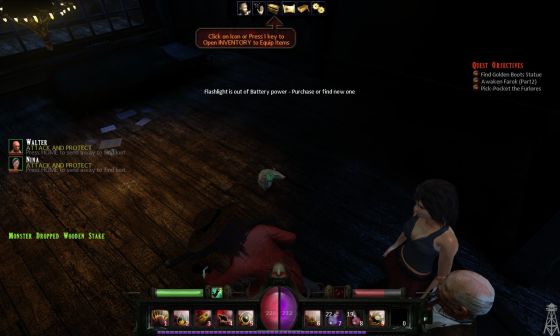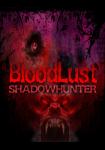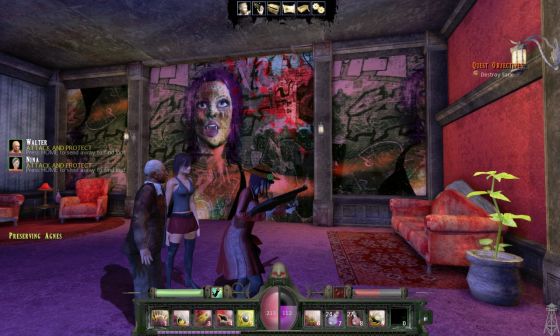Bloodlust: Shadowhunter Review
Let's face it. Most B-movies are garbage. However, occasionally you run into one that despite its second rate actors, cheap effects, and obvious shoestring budget emits a certain charm. It's the kind of film you'd be hard pressed to call good, but you've seen it maybe three or four times because it's fascinating in its own way. Bloodlust: Shadowhunter reminds me odf that. Monsters spawn out of the floors or fall out of the ceilings. My moronic vampire minions keep getting caught on doorways and as often as not sit by and do nothing instead of attacking like they are supposed to. The voice acting is amateurish. The models leave something to be desired. And yet the game is full of interesting ideas, even if they are not all worked out very well. It has a great inventory system, and is extremely ambitious for what essentially was a one man effort.
Gameplay
So what kind of game is Bloodlust: Shadowhunter? Well it's actually sort of two games. The first game takes place in a handful of endless deep dungeons. That part of the game is very reminiscent of the first Diablo or the Torchlight predecessor Fate. All the levels are randomly generated and filled with tons of randomly generated loot. The deeper you delve into the dungeons, the better the loot you can find. The second part of Bloodlust: Shadowhunter takes place upon the surface in a city dominated by vampire clans. The clans are forced into obedience to the vampire prince Ranior and his wicked henchman Sarx. Of course the clans would like to change this as much as they would like to sabotage each other. This part of the game resembles a traditional RPG with puzzles, quests, and NPCs. It serves as the skeleton of the game and gives you a reason to plunge even more time into the dungeons.

Just a small taste of the skill system
Bloodlust Shadowhunter's RPG system is for the most part reminiscent of Diablo, but there are some very interesting and unusual differences. First you play a vampire, and most of your abilities are very vampiric in nature. Also there is an open skill system with one constraint. Almost every skill is associated with one of the vampire clans. Vangres is a clan of warriors. Scades specializes in ranged weapons and thieving abilities. Vurkas has magical abilities allowing you to turn to mist, brew potions or summon spiders. The Furlores are beast like. The Mysterious Shadistin know mysteries of the blood. Each skill can only be unlocked and improved if your character has a high enough reputation with the respective vampire clan. How do you improve your reputation? One way is to do quests for a clan and the other way is to find random rare equipment, which belonged to a former clan member. If you find such equipment, you can put it into the clan stash to win their approval. While each clan starts with its own unique quest, subsequent missions are unfortunately all more or less the same and involve finding a statue somewhere in a random dungeon. There are also three skills not tied to a clan which are all very interesting and well done. Secret Sight not only lets you find secret doors and switches, but also improves your dark vision, eliminating, or at least reducing, your dependence on flashlights. Vampiric Eye lets you send out your vision through tiny holes so that you can push buttons or throw switches from a distance. Bite not only improves your ability to gain blood, which allows you to constantly regenerate your health and spiritual energy, but also increases the number of vampiric minions under you control. Minions can support you in battle or be sent off to search for items or spawn vampiric minions of their own. You get to choose your minions from the poor NPCs who roam the cities or who have gotten lost in its sewers or ruins.

By completing a quest for Clan Vurkas, I raise my skill cap in my magically oriented skills
As with the skill system, Bloodlust: Shadowhunter has a really interesting and deceptively complex loot system. Of course there are the standard weapons, armour, and accessories, identification scrolls, recall stones and gems for sockets, which are all typical of these types of action RPGs. There are also ingredients for alchemy, lockpicks, and safe cracking drill bits that are important for skills. In addition you find flashlights without which you can't see much (at least initially), tickets for the pawnshops, maps of some of the important surface locations in the game and calling cards for a special shop which lets you improve skills or buy maps. In addition there are talent stones, which helps unlock minor bonuses (there is also a chance you get one of these at each level up, depending on your intelligence attribute. There are also monkey stones. If you find a monkey statue in a dungeon and insert two monkey stones into its eyes you can drop ten or more levels deeper into a dungeons, which increases the danger, but also the chance to find really good loot. You also find keys, which are great, because almost every dungeon has locked doors behind which there usually are containers with more treasures.

One kind of loot you can find is a rat. Biting the little critter replenishes your blood pool
The Dungeons
Unfortunately, as great as the loot and character building system are, so plain and uninteresting are the dungeons themselves. The tilesets for all the random dungeons are dark and relatively boring. The swamp dungeon has water on the ground and the Egyptian, passages vases and coffins that definitely look more Egyptian than those in the normal dungeon do, but in general the dungeons have plain stone walls, plain stone floors, and look exceptionally generic.
Another problem is the creatures. There are actually a decent variety of enemies, and to be fair, most of them fit very well into the game's vampire theme. Unfortunately almost all these enemies simply move up to you and try to bang on you with their fists. There are very few ranged attackers and almost no enemies with interesting abilities. Also if an enemy gets caught on a wall or by one of your minions, they simply often respawn next to you. I suppose this prevents the game from getting to easy, but it's one of the game's practical if inelegant solutions.
Dungeons do have random elements. Pits going down, doorways leading out, traps, secret doors and puzzle chests (there is a "Simple Simon" and a "switch" puzzle chest) are distributed about the levels. Any given level can also be quite small or very large depending on your luck. These do give the dungeons a nice change of pace from just plain monster hunting. However, they also make the dungeons feel like a hodgepodge of random stuff, and that doesn't help the game's atmosphere.
The combat in Bloodlust is very much like you'd expect from a modern action RPG / hack and slay type game. You click on the opponent with your basic attack, or activate one of your skills with a hot key. You wait for the ability to become ready again and repeat. If you're fast enough you kill your opponent and if you're too slow you die. For the most part there isn't much of a consequence for dying. It's possible you'll be sent to a less dangerous dungeon level, but not much more happened to me, and my character didn't die all that often, especially in the last half of my play through.
The City
Your character awakes in a crypt with a mysterious letter and makes its way through a system of ruins, which turns out to be the game's tutorial. Bloodlust: Shadowhunter's tutorial is actually well done and introduces the player to most of the game's mechanics. Once you escape the ruins you'll find yourself in the city. The city turns out to house not only a few shops like the tattoo parlor, where we are supposed to meet our mysterious benefactor, but also the headquarters of a number of vampire clans. In contrast to the impersonal dungeons, the city's handcrafted locations are the visual and atmospheric highlights of Bloodlust: Shadowhunter.
Compare the beautifully designed Vurkas headquarters to the completely uninteresting random dungeon level. Unfortunately you spend most of your time in the latter
While trying to find out who you are, you stumble through the story, meeting various NPCs. The story and atmosphere tries to give the player the feeling of mystery and dread, but only partially succeeds. On the one hand due to the quality of the voice acting and on the other because the story errs on being to sparse with its details and explanations. Why, for example the main character becomes so bent on destroying certain vampires is still unclear to me.
Eventually you'll have the pleasure of exploring the various places in the city, many of which turned out to be handcrafted dungeons. These look much better than the procedurally generated ones, and are full of secrets and puzzles. The puzzles in Bloodlust: Shadowhunter tend to be more perception oriented than logical. You need to make best use of your mist form, secret sight and vampire eye abilities, which will in turn help you find various quest items. Like in many adventure games these items will grant you access to other areas. In fact one of the last missions involves a rather large amount of exploration and discovery of quest items in some areas to be used in others. There are also a number of other puzzles which involve pressure plates, hidden switches, and other secrets. The difficulty of these is greatly dependent on whether you've been able to find, or purchase, a map of the areas you are exploring. The game seems to indicate that there is a map for every city location, though I am not sure if that's true. Randomness plays a huge role in how easy some puzzles are, which I personally don't think is a particularly good game design. I never found a map for the theatre, for example, and ended up drawing out my own, because there's no way to really solve the puzzle through trial and error.
The city quests have a nice amount of variety, but unfortunately not all are executed equally well. For example, I got a quest at the pawn shop to find some special bullets. After accepting this quest I started selling stuff, sifting through my inventory, than selling more stuff. What I didn't realize was that the quest "advanced" each time I talked to the shop keeper. The result was that he became angry with me and wouldn't talk to me anymore. This wouldn't have been a major problem except that the game has a save system like Diablo. The game autosaves when you exit. I also blew a stealth mission later and unlike the pawn shop mission, I had no chance to repeat it by increasing my persuasion attribute. I personally don't mind such an autosave system in a hack and slay game where death isn't such a big deal, but find it strange in a game that has a quest system like Bloodlust: Shadowhunter has.

I would have saved myself lots of time if I had had a map for this puzzle
Conclusion
In an age where many games try to be simple and sleek, copying whatever game is currently popular, and do little wrong, but also little of interest, Bloodlust: Shadowhunter is complex and ambitious and does lots of things wrong, but also has lots of interesting stuff. It's like a combination of Torchlight, Vampire: Bloodlines and a puzzle oriented adventure game designed by one guy on a shoestring budget. Its interesting character and inventory system are offset by its uninteresting combat and generic dungeons, its clan system and quests by its animations and visuals. I would have loved to have seen such a cool concept for a game made by a team of experienced, professional developers with a decent budget, but probably none of them would have dared to undertake such a project. I enjoyed Bloodlust: Shadowhunter for 19 hours. It's theoretically an endless game, depending only on how much time you invest in its procedurally generated dungeons. I personally spent as little time in them as possible and still didn't finish the entire main quest, which I'm estimating would take 23-25 hours if one doesn't do much extra dungeon crawling. How much you'll enjoy Bloodlust: Shadowhunter is dependent on how much you'll embrace its vision and how much you'll forgive its faults. And there is plenty of both.

Information about
Bloodlust: ShadowhunterDeveloper: WRF Studios
SP/MP: Single-player
Setting: Modern
Genre: Dungeon Crawler
Combat: Real-time
Play-time: 20-40 hours
Voice-acting: Partially voiced
Regions & platforms
World
· Homepage
· Platform: PC
· Released: 2015-09-21
· Publisher: WRF Studios
More information
Other articles
Summary
Pros
- Interesting skill system
- Massive variety of loot
- Successfully combines a variety of game mechanics
- Vampire atmosphere implemented well
Cons
- Combat not particularly interesting
- Boring random dungeons
- Companion AI
- Save system
- Presentation in general feels amateurish



